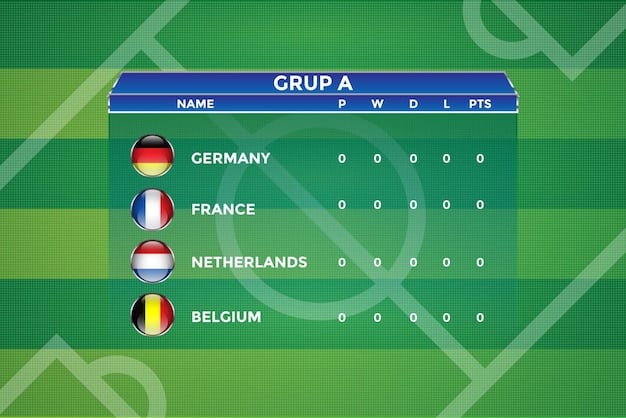World Cup 2026: USA’s Qualifying Journey Explored

Understanding the qualification process for the 2026 FIFA World Cup, co-hosted by the USA, involves intricate details regarding the automatic berths and the expanded format, significantly impacting how the US Men’s National Team prepares and participates in this historic event.
As the anticipation for the 2026 FIFA World Cup grows, particularly with North America set to co-host, understanding the qualifying process becomes paramount. For fans of the US Men’s National Team (USMNT), questions abound regarding their path to the tournament. This comprehensive guide, World Cup 2026: A Guide to Understanding the Qualifying Process for the US Team, aims to demystify the journey, shedding light on the automatic qualification and what it means for the USMNT’s preparations, competitive schedule, and overall strategy for the biggest soccer event on home soil.
The Unique Position of the Co-Hosts in World Cup 2026
The 2026 FIFA World Cup marks a historic moment, not least because it will be the first to be co-hosted by three nations: Canada, Mexico, and the United States. This tripartite hosting arrangement brings with it unique implications, especially concerning qualification. Typically, host nations automatically secure a spot in the tournament, a tradition that alleviates the pressure of navigating rigorous qualifying campaigns. However, with three hosts, the dynamics shift.
Traditionally, the host nation receives an automatic berth in the tournament. This ensures that the local fans have a team to cheer for and provides a strong foundation for marketing and logistical planning. For 2026, FIFA confirmed that all three host nations—Canada, Mexico, and the United States—will receive automatic qualification spots. This decision was made on the grounds of sporting merit and operational considerations, recognizing the significant investment and logistical undertaking required from each hosting country.
Automatic Qualification: What it Means for the USMNT
For the US Men’s National Team, automatic qualification is a double-edged sword. On one hand, it guarantees their presence at the pinnacle of international soccer, removing the stress and potential pitfalls of a grueling CONCACAF qualifying schedule. This allows the team to focus on long-term development, tactical experimentation, and player integration without the immediate pressure of must-win competitive fixtures.
On the other hand, the absence of competitive qualifying matches could pose challenges. The intensity and pressure of World Cup qualifiers are often seen as crucial preparation, forging team chemistry and mental fortitude under duress. Without these, the USMNT will need to be strategic in their scheduling of friendly matches and participation in other tournaments to ensure they are adequately prepared for the high stakes of the World Cup.
- Guaranteed Spot: No need to compete in the CONCACAF qualifying rounds.
- Strategic Planning: More freedom for coaching staff to test formations and players.
- Injury Prevention: Reduced travel and match congestion minimizes risk for key players.
The decision to grant automatic berths to all three hosts was officially announced in February 2023. This move was widely expected, aligning with FIFA’s practice for past multi-host tournaments, such as the 2002 World Cup hosted by South Korea and Japan. The benefit for the USMNT is clear: an assured presence on the world stage, enabling early preparations for what will undoubtedly be a monumental event for soccer in North America.
While the direct path to the tournament is secured, the USMNT’s technical staff will now pivot their focus entirely to optimizing their roster and strategies for July 2026. This period will be characterized by intensive scouting, nuanced tactical adjustments, and an emphasis on nurturing emerging talent, all without the immediate burden of securing qualification points.
The Expanded World Cup Format: 48 Teams and New Dynamics
The 2026 FIFA World Cup will introduce a significant expansion, moving from 32 to 48 participating nations. This change fundamentally alters the tournament’s structure, the number of matches played, and the opportunities for more countries to compete on the global stage. This expansion is designed to make the World Cup more inclusive, offering a broader representation of footballing nations from around the globe.
The decision to expand was part of FIFA’s long-term vision to grow the game internationally. It means more spots are available for confederations, which in turn means more teams from each region will have a chance to qualify. This could potentially dilute the quality of some group stage matches, but it also creates more compelling narratives and upsets, increasing global viewership and engagement.
Impact on Qualification Slots by Confederation
With 48 teams, the number of guaranteed berths for each confederation has increased. Here’s a breakdown of the new allocation, excluding the three host nations (USA, Canada, Mexico) who qualify automatically through CONCACAF:
- AFC (Asia): 8 direct slots (up from 4.5)
- CAF (Africa): 9 direct slots (up from 5)
- CONCACAF (North, Central America and Caribbean): 3 direct slots (+3 hosts = 6 total effectively, up from 3.5)
- CONMEBOL (South America): 6 direct slots (up from 4.5)
- OFC (Oceania): 1 direct slot (up from 0.5)
- UEFA (Europe): 16 direct slots (up from 13)
In addition to these direct slots, there will be an inter-confederation play-off tournament involving six teams to determine the final two berths. This play-off tournament will feature one team from each confederation, except UEFA, plus an additional team from the host confederation (CONCACAF). This mechanism ensures a competitive final sprint for the remaining places, adding an extra layer of drama to the qualification process.
- Increased Participation: More nations get a chance to compete at the highest level.
- Revised Group Stage: Potential for 16 groups of three teams, followed by a knockout stage starting with 32 teams.
- More Matches: The tournament will feature 104 matches, up from 64, making it the longest World Cup ever.

The new format presents both opportunities and challenges. While it offers a wider global reach for the tournament, concerns linger about the intensity and competitive balance of the group stage. Nevertheless, it undeniably marks a new era for the World Cup, one that reflects FIFA’s ambition for broader global football development. For the USMNT, this expansion means they will be part of a pioneering tournament, setting a precedent for future World Cups.
The expansion guarantees that the 2026 World Cup will be the biggest in history, not just in terms of the number of participating teams but also in matches played and potential global viewership. This new dynamic will undoubtedly reshape how national federations approach their long-term development strategies.
The USMNT’s Preparations and Strategic Planning for 2026
With automatic qualification secured for the 2026 World Cup, the US Men’s National Team faces a unique preparatory phase. Unlike previous cycles where the focus was on navigating the rigorous CONCACAF qualifiers, the next two years will be dedicated to fine-tuning the squad, experimenting with tactics, and ensuring peak performance for the home tournament. This period presents an unprecedented opportunity for long-term development.
The coaching staff, led by Gregg Berhalter as of the recent re-appointment decisions, will prioritize consistency in squad selection where possible, but also be open to integrating new talent. Their emphasis will shift from achieving results in high-stakes qualifiers to building a cohesive unit capable of competing with the world’s elite on their own turf. This includes refining defensive structures, enhancing attacking fluidity, and strengthening set-piece capabilities.
Key Areas of Focus Ahead of 2026
The preparation strategy for the USMNT will incorporate several critical elements:
- Player Development and Integration: Monitoring the progress of young talent playing both domestically and abroad. Integrating promising players into the senior squad through selective call-ups for friendly matches and minor tournaments.
- Tactical Experimentation: Using friendly windows and competitions like the CONCACAF Nations League and potentially the Copa América as opportunities to test different formations, strategies, and player roles. This allows for flexibility and adaptability against diverse opponents.
- Competitive Exposure: Actively seeking high-profile friendly matches against top-tier European and South American national teams. These matches are crucial for assessing the team’s standing against potential World Cup opponents and identifying areas for improvement under competitive conditions.
- Squad Depth and Versatility: Building a robust squad where multiple players can competently fill key positions. Creating a team that thrives on versatility, allowing for in-game adjustments and adapting to various match scenarios.
The absence of qualifying pressure means the USMNT can be more deliberate and less reactive in their planning. They can afford to invest time in developing specific aspects of their game, whether it’s perfecting a high-press system or enhancing their transition play. This extended preparation window is a luxury not typically afforded to nations battling through demanding qualification cycles.
Furthermore, the physical and mental well-being of the players will be carefully managed. Reduced travel burden from eliminating qualifying matches means less fatigue and more recovery time, ideally leading to players arriving at the World Cup in prime condition. The ultimate goal is to field a team that is not only talented but also cohesive, resilient, and tactically astute, ready to make a deep run in the tournament at home.
This period of strategic planning will be under intense scrutiny from both critics and supporters. The key measurement of success won’t be points in a table, but rather the visible progress in team chemistry, tactical sophistication, and the overall competitiveness displayed in friendlies and other regional competitions.
Potential Competitive Schedule and Friendlies
Without the traditional CONCACAF World Cup qualifying schedule, the USMNT’s fixture list will look significantly different in the lead-up to 2026. This void provides both a challenge and an opportunity to craft a high-quality competitive calendar designed specifically for World Cup preparedness. The focus will largely shift towards utilizing international breaks for strategic friendly matches and participating in other regional tournaments.
The US Soccer Federation will be working closely with other national associations to arrange friendly matches against a diverse range of opponents from different confederations. Facing teams with varying styles of play—from the technical prowess of South American giants to the tactical discipline of European powerhouses—is essential for developing versatility and adaptability within the squad. These matches offer invaluable insights into the team’s strengths and weaknesses against global competition.
Key Tournaments and Fixture Opportunities
Beyond friendly matches, several standing competitions will form a crucial part of the USMNT’s competitive calendar:
- CONCACAF Nations League: This biennial competition provides competitive matches against regional rivals. While not on the same level as World Cup qualifiers, it offers opportunities for squad rotation, tactical testing, and maintaining a winning mentality.
- Copa América 2024: The United States is set to host the Copa América in 2024, featuring 10 CONMEBOL teams and 6 CONCACAF teams. This tournament is arguably the most significant competitive preparatory event for the USMNT. It will pit them against some of the world’s strongest national teams (e.g., Brazil, Argentina), providing a real litmus test for their World Cup ambitions. The high-stakes environment of this tournament will be crucial for simulating World Cup pressures.
- Gold Cup: While perhaps a slightly lower priority compared to Copa América or high-profile friendlies, the CONCACAF Gold Cup still offers opportunities for competitive minutes, especially for fringe players or those returning from injury.
The scheduling of these fixtures will be meticulously planned to ensure a balance between competitive intensity and player welfare. Managing travel, rest periods, and potential injuries will be paramount for ensuring the squad is fresh and ready for 2026. This strategic approach to scheduling aims to replicate the varied challenges a team faces during a World Cup campaign, exposing players to different tactical approaches and psychological pressures.

The overarching goal for these competitive opportunities is to build chemistry, refine tactical systems, and foster a winning culture within the team. Each match, regardless of its official status, will be treated as a valuable learning experience, with the ultimate objective of peaking at the 2026 World Cup.
By engaging in a mix of high-stakes tournaments and diverse friendly matches, the USMNT aims to arrive at the 2026 World Cup not only with a strong roster but also a wealth of experience against various international methodologies, ensuring they are well-prepared for any challenge.
Fan Engagement and the Home Advantage for US Soccer
The 2026 FIFA World Cup being co-hosted by the United States presents an unparalleled opportunity for fan engagement and leveraging the significant home advantage. With matches spread across numerous US cities, the tournament is poised to galvanize the domestic soccer landscape and leave a lasting legacy for the sport in America. The sheer scale of the event will ensure unprecedented levels of interest and participation from local communities.
The “home advantage” extends beyond mere familiarity with pitches and climate. It encompasses the psychological boost derived from passionate, vocal support from stands packed with local fans. This fervent atmosphere can be a significant factor in high-stakes matches, providing an emotional lift to players and potentially intimidating opposition teams. For the USMNT, this will mean playing in front of overwhelmingly supportive crowds throughout their tournament journey.
Maximizing the Home Ground Benefit
The US Soccer Federation and the local organizing committees will be focused on maximizing this home benefit in several ways:
- Ticket Allocation and Fan Zones: Ensuring robust ticket access for US fans will be key, alongside establishing vibrant fan zones in host cities. These zones will create communal viewing experiences and celebratory spaces, amplifying the World Cup atmosphere.
- Grassroots Engagement: Utilizing the World Cup as a platform to inspire the next generation of soccer players and fans. This involves community outreach programs, youth clinics, and showcasing the sport’s potential through school initiatives.
- Cultural Connection: Highlighting the diversity of US soccer fandom, which includes strong ties to various international teams. This creates a unique multicultural backdrop for the tournament, celebrating both domestic and global footballing passion.
- Travel and Logistics: Reduced travel burden for the USMNT, no long-haul flights or significant time zone changes between matches early in the tournament. This allows players more recovery and training time, optimizing physical conditioning.
The excitement around hosting the World Cup is already palpable across the United States. Cities selected as host venues are making significant investments in infrastructure, security, and fan experiences. These preparations are not just for the tournament itself but are part of a broader strategy to leave a sustainable legacy for soccer in the country, from youth development to professional leagues.
Beyond the stadium experience, the tournament offers a unique platform for cultural exchange. Fans from around the world will descend upon the US, sharing their passion for the game and experiencing American culture. This cross-cultural interaction enriches the overall World Cup experience, making it a truly global festival.
Ultimately, the combination of a passionate home crowd, favorable logistical conditions, and strategic pre-tournament planning positions the USMNT to potentially exceed expectations. The tournament represents a historic opportunity to elevate soccer’s profile within the United States significantly, cementing its place as a major sport.
Challenges and Opportunities for Player Development
While automatic qualification removes the immediate pressure of World Cup qualifiers, it introduces a different set of challenges and opportunities for player development within the USMNT system. The direct path to 2026 demands a strategic approach to nurturing talent, ensuring competitive readiness, and sustaining player engagement without the traditional competitive calendar.
One primary challenge is maintaining competitive sharpness. The intensity of qualifying matches often brings out the best in players, forcing them to perform under high pressure. Without these fixtures, the coaching staff must create alternative environments that simulate this competitive intensity. This extends to player selection, focusing on those who are consistently performing at top levels for their clubs, regardless of league.
Navigating the Development Landscape
Key aspects of managing player development include:
- Maximizing Club Performance: Encouraging US players to seek and secure roles at top-tier clubs in competitive leagues globally. Consistent playing time at a high level is paramount for development, exposing players to different tactical systems and matchday pressures.
- Strategic Use of Friendlies and Minor Tournaments: Leveraging all international windows for friendly matches against varied opposition. These matches become crucial testing grounds for emerging talent, tactical shifts, and team cohesion.
- Youth Pathway Integration: Strengthening the pipeline from youth academies and development leagues to the senior national team. This involves meticulous scouting, targeted training camps for promising young players, and facilitating smooth transitions into the professional ranks.
- Identifying and Addressing Weaknesses: The extended preparation period allows for a more detailed analysis of individual player weaknesses and team deficiencies. Tailored training programs and tactical adjustments can be implemented to address these areas proactively.
The opportunity lies in deliberate, long-term planning. The USMNT coaching staff can afford to be patient with player development, allowing emerging talents to mature at their own pace rather than being rushed into high-stakes environments prematurely. This also creates a broader pool of talent to choose from, increasing the depth and quality of the squad.
Furthermore, without the constant travel and physical demands of qualification, players may arrive at the World Cup in better physical condition. This reduced wear and tear can translate into fresher legs and sharper minds for the tournament itself.
The challenge will be to ensure that players truly absorb the strategic lessons from non-competitive matches with the same urgency as they would in a qualifier. The mindset must be that every minute on the pitch, every training session, is a step towards 2026. Ultimately, the success of this unique cycle will be judged by the USMNT’s performance when the World Cup kicks off on home soil.
This phase is not just about physical preparation, but also about cultivating a strong team identity and mental resilience. Building a squad that can perform consistently under immense pressure will be the true measure of success for the USMNT’s unique qualification journey.
The Legacy of 2026: Beyond the Tournament
The 2026 FIFA World Cup is more than just a football tournament for the United States, Canada, and Mexico; it represents a monumental opportunity to leave a lasting legacy for the sport across North America. This legacy will extend far beyond the final whistle, impacting infrastructure, participation rates, and the cultural perception of soccer for decades to come. The scale of this event is unparalleled in modern sports.
Hosting such a globally significant event spurs significant investment in local communities. This includes upgrades to stadiums, public transportation systems, and hospitality infrastructure. These improvements benefit not only the tournament but also local residents and future events, cementing the host cities’ status as world-class venues.
Impact on Soccer Development in the United States
For US Soccer, the legacy of 2026 will be multi-faceted:
- Increased Participation at All Levels: The exposure and excitement generated by the World Cup on home soil are expected to drive a surge in youth soccer participation, from grassroots leagues to high school and college programs. This creates a larger talent pool for the future.
- Enhanced Professional Leagues: Major League Soccer (MLS) and other professional leagues in the US stand to benefit immensely. Increased viewership, new fans, and potential investment could elevate the quality and profile of domestic club football, making it a more attractive destination for top talent.
- Improved Coaching and Player Development Pathways: The spotlight on the national team and the global game will likely lead to greater emphasis on coach education, sports science, and state-of-the-art training facilities. This holistic improvement in development pathways will benefit generations of future players.
- Cultural Integration of Soccer: While soccer has grown significantly in the US, the 2026 World Cup provides an opportunity to firmly establish it alongside traditional “big four” sports. The pervasive media coverage, fan engagement, and national pride associated with hosting will solidify its place in the American sporting consciousness.
The economic impact will also be substantial. Tourism, job creation, and increased consumer spending will provide a significant boost to the host cities and the national economy. This financial injection can be reinvested into sports infrastructure and community programs, furthering the positive cycle of development.
Furthermore, the World Cup will serve as a platform for international diplomacy and cultural exchange. Bringing together fans and teams from diverse backgrounds fosters understanding and goodwill. It’s an opportunity for the United States to showcase its hospitality, multiculturalism, and passion for the beautiful game to a global audience.
In essence, the 2026 World Cup is not merely an event but a catalyst for profound and positive change within the American soccer landscape. The strategic planning now, leading up to the tournament, is designed to ensure that the legacy is not just immediate celebration but sustained growth and prosperity for the sport.
The long-term vision is clear: to leverage the global spectacle of 2026 to inspire a new generation of players, expand the fan base, and establish the United States as a true footballing nation on the world stage, capable of consistently competing for top honors.
| Key Aspect | Brief Description |
|---|---|
| 🇺🇸 Automatic Qualification | The USMNT, along with Canada and Mexico, automatically qualify as co-hosts, bypassing traditional qualifiers. |
| ⚽ Expanded Format | The 2026 World Cup will feature 48 teams, leading to increased slots for all confederations and more matches. |
| 📈 Strategic Preparation | USMNT will focus on tactical experimentation, player development, and high-profile friendlies without qualifying pressure. |
| 🏡 Home Advantage & Legacy | Leveraging fan support and hospitality, the tournament aims to leave a lasting positive impact on US soccer development. |
Frequently Asked Questions about World Cup 2026 Qualification
▼
No, the USMNT will automatically qualify for the 2026 FIFA World Cup because the United States is one of the three co-host nations. This means they will not participate in the traditional CONCACAF qualifying rounds.
▼
The 2026 FIFA World Cup will be the first to feature an expanded format with 48 participating nations, up from the previous 32. This expansion increases the number of qualification slots available for each confederation.
▼
Automatic qualification allows the USMNT to focus on long-term strategic planning, including tactical experimentation, player development, and scheduling high-profile friendly matches against diverse international opponents without the pressure of competitive qualifiers.
▼
Yes, aside from the three host nations (USA, Canada, Mexico), other CONCACAF teams will still compete for the remaining direct qualification spots, which have also increased due to the expanded 48-team format. There will also be a slot in the inter-confederation play-off.
▼
The USMNT is expected to participate in the CONCACAF Nations League, the Gold Cup, and notably, the Copa América in 2024, which the US will host. These tournaments provide crucial competitive exposure against top international teams.
Conclusion
The road to the 2026 FIFA World Cup for the US Men’s National Team is unequivocally unique. With automatic qualification secured, the focus shifts from fierce preliminary battles to meticulous long-term preparation. This period offers an unprecedented chance to refine tactics, integrate emerging talent, and build a cohesive unit capable of excelling on home soil. The expanded 48-team format and the unparalleled home advantage present both opportunities and challenges, demanding strategic foresight and disciplined execution from the coaching staff and players. Ultimately, the 2026 World Cup is more than a tournament; it’s a pivotal moment for soccer in the United States, poised to inspire a new generation of fans and players, leaving an enduring legacy for the beautiful game across North America.





